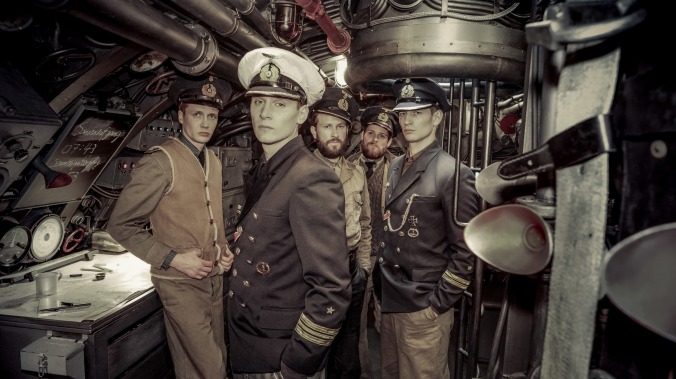Hulu’s Das Boot miniseries is well-acted and well-crafted… but needs more boot


The cable and subscription streaming business lately seems determined to reinterpret an old saying: These days, history repeats itself, first as a tragedy, and then as a multi-part prestige TV drama. In just these past two months we’ve seen new adaptations of Catch-22 and The Name Of The Rose , both based on best-selling novels that have already been made into movies. Hulu just started airing the third season of The Handmaid’s Tale, another novel-turned-film-turned series. And starting Monday, Hulu is importing the German WWII drama Das Boot, drawn from Lothar-Günther Buchheim’s 1973 novel of the same name, which writer-director Wolfgang Petersen previously turned into a 1981 international blockbuster hit—and maybe the greatest submarine movie ever made.
But this new Das Boot (a.k.a. The Boat) is actually meant to function more as a sequel than an adaptation, taking aspects of the original novel along with some of Buchheim’s non-fiction wartime accounts, as well as pulling from Buchheim’s 1995 novel Die Festung (a.k.a. The Fortress), about the decline of the Nazis’ French stronghold. The result is a more open-ended narrative—for a show that’s already renewed for a second season—presenting a larger picture of the German experience of the war.
In other words: Unlike the 1981 Das Boot, the TV version only spends about a third of any given episode following the crew of a submarine. And whenever it gets out of the boat, it doesn’t really feel much like Das Boot.
That’s not necessarily a knock against the show. One of the best things the new Das Boot has going for it is the performance of Vicky Krieps, whom American audiences will know best as the model/girlfriend who interferes with Daniel Day-Lewis’ life in Paul Thomas Anderson’s period drama Phantom Thread. Here Krieps plays Simone Strasser, who arrives in the western French outpost of La Rochelle to work as a translator for the Nazis. She takes the position hoping to spend more time with her military radio operator brother Frank (Leonard Schleicher), but in the first episode, he gets reassigned. Before he leaves, Frank lets Simone in on a secret: He’s been funneling intel to his French girlfriend Natalie (Clara Ponsot), who’s been working with an American secret agent, Carla (Lizzy Caplan). And he needs Simone to carry on the mission in his absence.
The implication is that Frank has been working with the French resistance, but the show doesn’t spell that out in the early episodes—nor does it indicate whether Simone herself is sympathetic to the Resistance cause, or if she’s just doing a favor for her brother. What is clear by the end of episode two is that Simone is in way over her head. She’s not cut out to do what Carla needs her to do, which includes shuttling documents around La Rochelle, and sneaking drugs into a jail cell.
American TV viewers will also recognize Better Call Saul bit player Rainer Bock as a smug, desk-bound naval officer, who blithely sends his ships into dangerous waters because he’s slow to realize that the Allies have decrypted the coded messages of the Germans’ Enigma machine. Game Of Thrones actor Tom Wlaschiha (who played Faceless assassin Jaqen H’ghar) also plays a major role here, as Gestapo officer Hagen Forster, who ruthlessly tortures Resistance fighters, yet has a blind spot and an unrequited passion for Simone.
Das Boot’s land-bound storylines serve multiple functions. The movie takes place almost entire underwater with a bunch of sweaty, smelly guys; but by opening the story up significantly for television, the series is able to diversify the cast, including different nationalities and a lot more women. This also allows the TV Das Boot to include more of the elements that modern prestige drama viewers expect: namely nudity and violence (and not “torpedoing a ship” violence but “rape, murder, and beating a civilian’s face into a raw, bloody pulp” violence).
But it’s hard to deny that the expansion often comes across as forced. The 1981 Das Boot memorably ends around Christmastime in 1941, with a tragic twist that underscores the wastefulness of war. The TV show picks up in the late summer of 1942, with an entirely new cast of characters, including the crew of a different German submarine. But Die Festung is based on Buchheim’s own experiences in France in 1944, and its whole “last months of the Nazi regime” backdrop doesn’t fully fit with the chronology of this new Das Boot.
What does still work well though are the submarine scenes. After opening with a harrowing sequence that shows a German U-boat getting sunk by a surprise attack from Allied forces, the TV Das Boot introduces a new submarine, U-612, captained by Klaus Hoffman (Rick Okon), the son of a WWI hero—and the nemesis of his more qualified first officer Karl Tennstedt (August Wittgenstein). A book-taught sailor who has no business at the helm of a ship, Klaus understandably struggles to win the respect of his crew, who—as in the movie—aren’t universally partial to Nazism, but are instead in many cases just career sailors and enlisted men, anxious to survive.
Next to Krieps, the consistent highlight of Das Boot are the moments where U-612 is in crisis, often due to the captain’s poor decisions. The show’s clearly substantial budget is evident in the moments when the large cast is scrambling through the cramped corridors of the submarine, panicking about the possibility of being blown out of the water by the enemy, or of running out of fuel, food and oxygen in the middle of the ocean.
Later in the eight-episode first season, the troubles both at sea and in La Rochelle lead to some horrifyingly immoral choices, made even by those handful of characters that Das Boot has positioned as somewhat sympathetic. Also, for those patient enough to make it fairly deep into this season, Mad Men’s always excellent Vincent Kartheiser eventually appears, playing a shady American businessman in need of a favor, and in the process forced to confront what the war means in practical terms.
It will take some stick-to-itiveness to get that far though, because Das Boot isn’t the easiest show to get into. Each episode is long, coming in at right around an hour. And while each of those hours typically features some sort of task that’s introduced and completed by the closing credits, it’d be a stretch to call the series “episodic.” The eight chapters tend to blur together, and to move at such a leisurely pace that they don’t exactly pull audiences along or encourage binging.
And, frankly, splitting the action between the sub and the shore robs this Das Boot of one of the film’s essential elements: the sense of “you are there” claustrophobia and panic, which back in 1981 had the perverse effect of getting even American moviegoing audiences to root for Nazi sailors to survive. The original Das Boot remains one of the most popular foreign-language films ever to play in the United States, and a big reason for that was because its gripping story of narrow escapes and daring descents divorced the war movie genre from any ideology, and instead urged viewers instead to see the enemies in what is widely acknowledged as one of the “good wars” as human beings. Even now, the movie’s as provocative as it is pulse-pounding.
The series is nowhere near as grabby. But it does explore similar themes, which are still worth engaging… again, for those willing to make the effort. Wolfgang Peterson’s Das Boot has been cut and re-cut and expanded multiple times since it debuted, but the core of the story has always remained the same: It’s a white-knuckle thriller about how the moment-t0-moment demands of war cause people to act against their natures and their codes. And no matter where the TV version goes, it’s equally concerned with the regular schmoes who actually fight the battles the ideologues design.